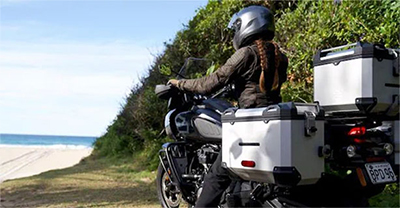The specific terms and conditions for adding named riders to a motorcycle insurance policy can differ considerably among various insurance companies. Therefore, it is essential for policyholders to compare policies and thoroughly understand the specific rules and requirements of each insurer before making a decision.
Adding a named rider to your motorcycle insurance policy is an important consideration when someone else regularly rides your motorcycle or shares your home.
This process ensures proper coverage for all riders and can help avoid potential insurance complications if an accident occurs.
Whether you're adding a family member, roommate, or friend who frequently borrows your bike, understanding the proper procedures and requirements is essential for maintaining appropriate coverage.
WHAT IS A NAMED RIDER IN MOTORCYCLE INSURANCE?
A named rider (also called an additional driver) is someone who is specifically listed on your motorcycle insurance policy as an authorized operator of your motorcycle. This differs from occasional permitted use by friends or family, which may be covered differently depending on your policy.
This designation ensures that in the event of an insurance incident, while the named rider is operating the vehicle, the insurance policy will provide motorcycle insurance coverage, subject to the terms and conditions outlined in the policy documents.
ADDING ADDITIONAL DRIVERS TO YOUR POLICY: IS IT POSSIBLE?
Yes, adding an additional driver to your policy is possible. To successfully add a named rider to a motorcycle insurance policy, the insurance company will typically require specific information about the individual being added. This information is crucial for the insurer to accurately assess the risk they are undertaking by extending coverage to another driver.
Full Legal Name
The insurer will need the full legal name of the named rider, exactly as it appears on their official driver's license. They will also require the named rider's date of birth. These details help the insurer verify the identity of the individual and assess their age-related risk profile.
Driving License Details
Providing comprehensive driving license details are essential. This includes the named rider's driver's license number and the date when they were first licensed to drive a motorcycle.
Many insurance policies explicitly exclude coverage if the rider does not hold the correct and valid license.
Driving History
The insurance company will typically inquire about the named rider's driving history. This includes details of any past insurance incidents they have been involved in, any insurance claims they have made, and any traffic violations they have incurred.
This information is a significant factor in assessing the named rider's risk profile, as a history of accidents or violations may indicate a higher likelihood of future incidents, potentially influencing the insurance premium or the insurer's decision to add the rider.
Note* While not always mandatory, some insurers might also ask about the relationship between the policyholder and the named rider to better understand the context of the shared motorcycle usage.
WHO SHOULD BE ADDED AS A NAMED RIDER?
The main rider is generally understood to be the person who uses the motorcycle with the greatest frequency. Not everyone who might occasionally ride your motorcycle needs to be added to your policy.
However, certain situations typically warrant adding someone as a named rider:
Household members who ride your motorcycle: Motorcycle insurance companies generally require or strongly recommend that you add anyone living in your household who might operate your motorcycle. This includes spouses, significant others, children with motorcycle licenses, and roommates.
Regular operators: Anyone who frequently rides your motorcycle should be added to your policy, even if they don't live with you. This ensures they have proper coverage when using your bike.
Co-owners: If you share ownership of a motorcycle with someone else, both owners typically need to be listed on the policy. In most cases, the primary policyholder should be the person named on the motorcycle's title.
Insurance requirements vary between companies, but many insurers require you to add all licensed riders in your household to your policy, even if they rarely ride your motorcycle. This is because insurance companies assume that people living together have access to each other's vehicles.
For a named rider to be covered under the insurance policy, both the main rider and the named rider must receive approval from the insurance provider. Furthermore, their names will be explicitly stated in the policy declarations page, serving as formal recognition of their insured status.
WHY CONSIDER ADDING A NAMED RIDER?
Several compelling reasons exist for a motorcycle owner to consider adding a named rider to their insurance policy.
First, if someone else, such as a family member or close friend, frequently rides the motorcycle, adding them as a named rider provides the assurance that they are covered under the existing insurance policy. This eliminates the uncertainty and potential financial risks associated with someone else operating the vehicle without explicit insurance coverage.
Secondly, ensuring that anyone operating the motorcycle with the owner's permission is legally covered by insurance is paramount. Operating a motorcycle without valid insurance is illegal in most states and can lead to severe penalties. By adding a named rider, the policyholder ensures that any regular secondary rider is legally compliant and protected from potential financial liabilities arising from an incident.
While the common perception might be that adding any rider increases insurance costs, there are instances where adding a named rider could potentially lead to cost benefits. For example, if the named rider is older and possesses more riding experience with a clean driving record, their lower risk profile might offset the risk associated with the main rider, potentially resulting in a lower overall premium. This underscores the importance of considering the individual characteristics of the person being added to the policy.
Finally, while some insurance policies might extend limited coverage to permissive riders, who are individuals who occasionally borrow the motorcycle, adding a named rider offers more comprehensive and guaranteed coverage for those who use the bike regularly. Permissive rider coverage can be subject to various limitations and might not apply in all circumstances, making a named rider a more secure option for consistent secondary usage.
IMPORTANT LIMITATIONS AND ELIGIBILITY CRITERIA FOR NAMED RIDERS
While adding a named rider can be beneficial, it's important to be aware of certain limitations and eligibility criteria that insurance companies often impose.
Experience
Often correlated with age, driving experience is another critical factor. Insurers frequently require named riders to have a minimum number of years of holding a valid motorcycle license.
For instance, a requirement of at least 2 years of riding experience is not uncommon. This reflects the understanding that more experienced riders are generally less likely to be involved in a mishap.
Driving History
The named rider's driving record is also closely scrutinized. Insurers typically prefer named riders with a clean driving history, meaning no recent suspensions, disqualifications, or at-fault claims.
A history of such incidents suggests a higher risk to the insurer.
Additionally, individuals whose policy renewal has been declined or terminated recently by an insurance provider might also be ineligible to be added as a named rider.
Usage
Restrictions on how the motorcycle is used can also apply to named riders. Generally, the insured motorcycle should not be used for commercial purposes like rental or delivery by the named rider, even if such usage is declared for the main rider, unless explicitly covered under the policy.
Commercial use typically entails a higher level of risk and often requires a different type of insurance policy.
In some instances, the policyholder themselves must be listed as either the main rider or a named rider to be eligible for coverage under the policy. This ensures a direct link between the policy owner and the operation of the insured motorcycle.
STEP-BY-STEP GUIDE TO ADDING A NAMED RIDER
The process of adding a named rider to a motorcycle insurance policy typically involves several key steps.
1. Review Your Current Policy Documents
The first crucial step is to review the existing motorcycle insurance policy documents thoroughly.
This review will help the main rider understand the current terms and conditions of their coverage, specifically looking for any clauses that address the addition of drivers or named riders, including any specific conditions or restrictions that might apply.
2. Gather the Necessary Information
Once the policyholder understands their current coverage, the next step is to gather all the necessary information about the individual they wish to add as a named rider.
This information generally includes:
The rider's full legal name
Date of birth
Driver's license information (including license number and state of issue)
Driving history (including any insurance incidents or traffic violations)
Motorcycle riding experience
Having this information readily available will expedite the process of adding the rider.
3. Contact the Insurer
With the required information in hand, the policyholder should then contact their insurance provider to initiate the process of adding a named rider.
Most insurance companies offer multiple ways to contact them, including online through the policyholder's account or a mobile application, over the phone, or via email. The specific contact methods available will usually be listed on the insurance company's website or within the policy documents.
Upon contacting the insurer, the policyholder will need to provide the gathered details about the potential named rider through the insurer's preferred method. It is important to ensure that all the information provided is accurate and complete, as any discrepancies could potentially lead to issues with the policy or future claims.
4. Review the Revised Insurance Quote
After receiving the necessary information, the insurance company will assess the risk associated with the additional rider and provide a revised insurance quote.
This revised quote will reflect any changes in the insurance premium resulting from the inclusion of the named rider based on:
The new rider's age (riders under 25 typically incur higher premiums)
Riding experience (less experienced riders usually mean higher premiums)
Driving record (accidents or violations may increase costs)
The policyholder should carefully review this quote to fully understand how the addition of the named rider affects their premium and if there are any adjustments to the coverage terms.
5. Confirm the Policy Changes
If the policyholder agrees with the new terms and the revised premium, they will need to confirm the addition of the named rider with their insurance provider and make any necessary payments for the adjusted premium.
Once this is completed, the insurance company will update the policy documents to include the named rider, and it is crucial for the policyholder to ensure they receive these updated documents as official confirmation of the change.
FACTORS AFFECTING PREMIUMS
As noted above, several factors can influence the extent to which adding a named rider affects the premium, including:
Age
Use
Location
Experience
Claims history
Type of motorcycle
If the named rider is involved in an incident and a claim is made, it will be under the policyholder's policy and will likely impact their Claim-Free Renewal at the time of policy renewal. This means the policyholder bears the risk of claims made by the named rider.
SPECIAL CONSIDERATIONS
Before adding someone to your motorcycle insurance policy, consider these important factors:
Ownership Requirements
In most cases, you can only insure a motorcycle that you own. The primary policyholder (named insured) is typically the person listed on the motorcycle's title. However, there are some exceptions:
In some states, like Texas, you might be able to insure a motorcycle under your name even if the title is in someone else's name, but this varies by insurer.
When sharing ownership, the title holder usually needs to be the primary policyholder, with others added as additional drivers.
Policy vs. Rider Coverage
Understanding the distinction between types of coverage is important:
Adding a driver: This means the person is covered when riding your motorcycle but doesn't extend coverage to their own vehicles.
Sharing a policy: This typically means multiple motorcycles (yours and theirs) are covered under one policy (a multi-bike insurance policy), which is different from simply adding a rider to your existing motorcycle policy. In this scenario, it’s important to contact your insurance company to determine if you are eligible for one policy or if separate policies are required.
Household Requirements
Many insurance companies have specific rules regarding household members:
Some insurers require all licensed drivers in your household to be either added to your policy or explicitly excluded.
In some cases, adding one person to a policy might require listing them on all vehicles under that policy, including cars, other motorcycles, and even renters insurance if they're with the same company.
Alternative Coverage Options
If adding a named rider isn't the right solution for your situation, consider these alternatives:
Permissive Use Provisions
Most motorcycle insurance policies include "permissive use" provisions that provide some coverage when you allow someone else to ride your motorcycle occasionally. This typically applies when:
The rider has your explicit permission
They possess a valid motorcycle license
They're not a regular user of your motorcycle
However, permissive use coverage may be more limited than coverage for named riders, and policy specifics vary significantly between insurers.
CONCLUSION
Adding a named rider to your motorcycle insurance policy is an important step in ensuring proper coverage for everyone who regularly operates your motorcycle. The process typically involves contacting your insurance provider, providing information about the additional rider, and reviewing any premium changes. Understanding ownership requirements, household considerations, and alternative coverage options can help you make informed decisions about your motorcycle insurance policy.
Whether you're sharing a motorcycle with a family member, have a roommate who occasionally rides your bike, or frequently loan your motorcycle to a friend, proper insurance coverage protects everyone involved.
If you’re in doubt about specific requirements or options, contact our insurance experts to ensure you have appropriate coverage for your unique situation.
RELATED RESOURCES

No matter what type of bike you ride and no matter what type of coverage you need, here are 16 motorcycle insurance money-savers you may qualify for. Learn more!

Young motorcycle riders need insurance for protection and legal compliance. Learn how to get protected, essential coverages, and tips which may lower premiums.

The insurance logistics to test ride a motorcycle can be complicated if there is an unforeseen motorcycle incident. Here’s everything you need to know.

Discover everything you need to know about getting insurance after buying a motorcycle, along with some tips to ensure you’re covered.



